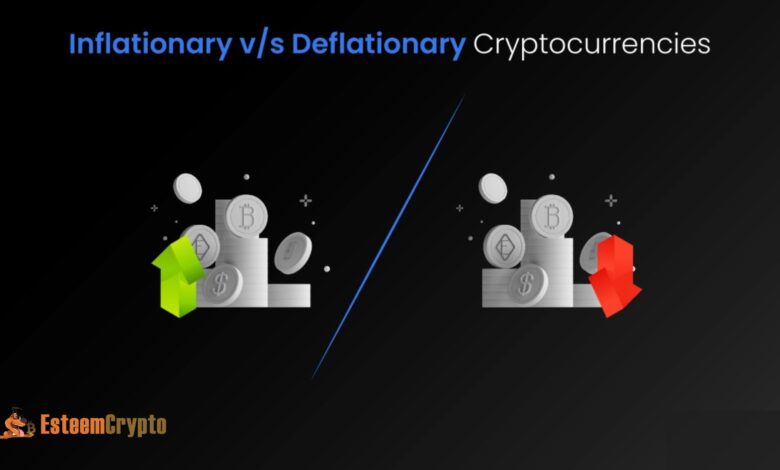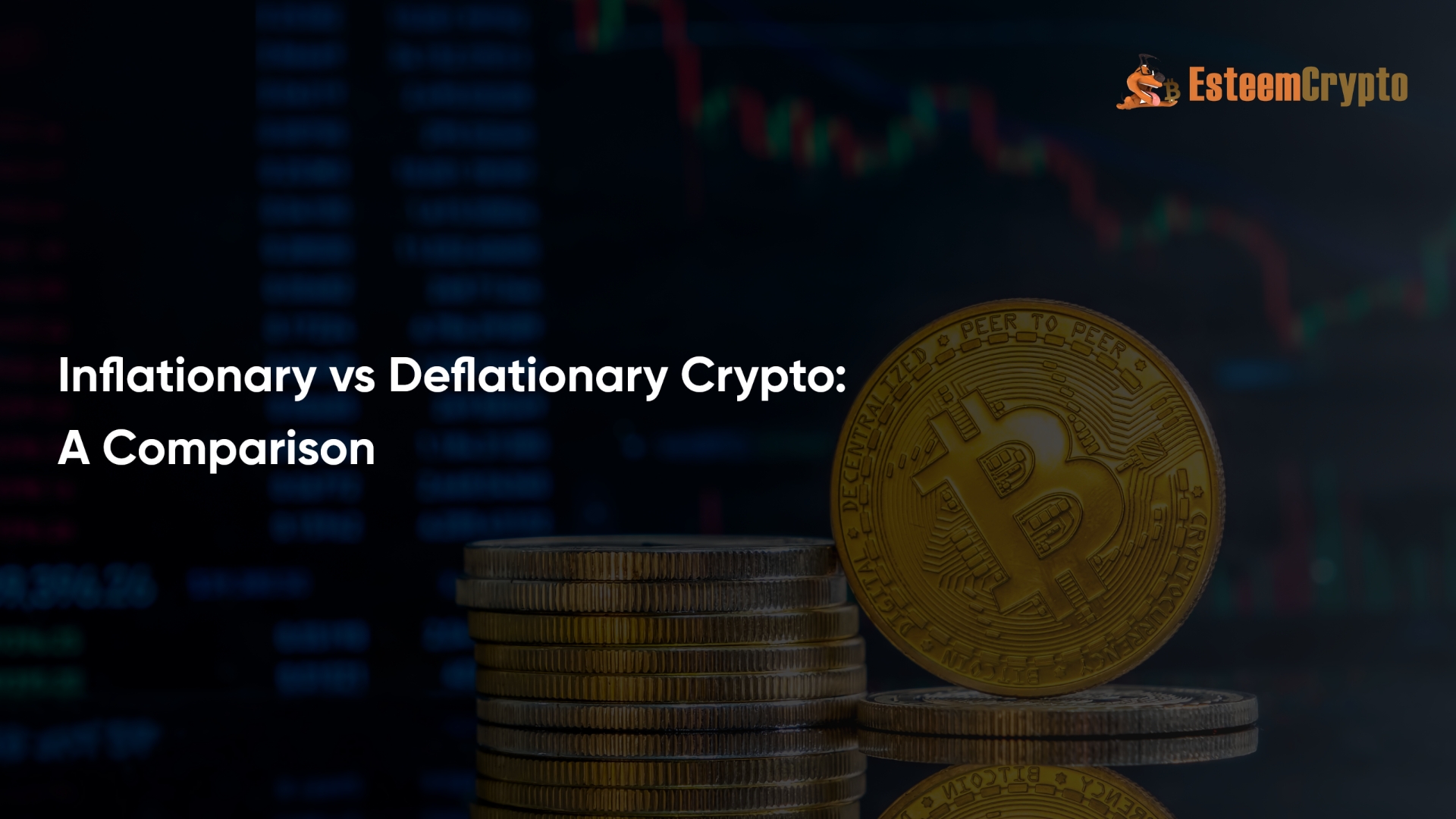Inflationary vs. Deflationary Cryptocurrencies: Key Comparison

Inflationary vs. Deflationary Cryptocurrencies: Key Comparison. One of the worst words for an economy is inflation, particularly for the world’s most excellent economy—the United States. 2022, the US inflation rate is predicted to be close to 8.5%. Considering that the inflation rate was approximately 7.0% in 2021, the rise in inflation is a clear highlight. Growing inflation has made price increases possible while applying pressure to keep wages from stagnating. As a result, the argument over whether cryptocurrencies would experience inflation or deflation has gained traction recently.
Many have viewed cryptocurrencies as an excellent way to hedge against rising inflation. You should know that cryptocurrencies can also be considered deflationary and inflationary assets. A thorough explanation of inflationary and deflationary cryptocurrencies and their distinctions may be found in the following post.
What is Inflation vs Deflation?
The distinction between inflation and deflation should be a primary focus of any debate over inflationary vs deflationary crypto. If you’re new to cryptocurrencies, you might think those two concepts came straight from an accounting textbook. Inflation occurs when money is abundant in circulation, which leads to a decline in the purchasing power of that money. As a result, prices for goods and services rise.
Conversely, deflation indicates that a currency’s value increases while prices for goods and services decrease. Remember that deflation sets in when the money supply is limited. A certain amount of inflation is beneficial since it stimulates spending, which helps the economy. However, inflation becomes a significant problem when wages do not keep pace with price increases.
The quantity of money in circulation is the key. Since their supply can be increased at will, fiat currencies tend to cause inflation. A currency unit loses purchasing power since total economic activity will always be the same. A rise in the buying power of the fiat currency is possible in a deflationary economy where demand falls and supply rises.
Inflationary Cryptocurrencies
Understanding inflationary and deflationary choices is crucial as the world turns to cryptocurrencies to fight inflation. Inflation and deflation apply to cryptocurrency because it relies on market forces. Inflationary cryptocurrencies have an increasing token supply. Mining and staking are popular ways to bring tokens to circulation. Increased token supply lowers its value. Thus, buyers will require more tokens to buy a product.
One of the best examples of inflationary cryptocurrencies is Dogecoin. A Dogecoin designer lifted the 100 billion DOGE hard cap in 2014. The relocation was meant to ensure asset availability. Since supply may exceed demand, all Dogecoin coins’ value would collapse.
Some assets, like Bitcoin, undergo inflation, but others do not. Since there are 21 million Bitcoins in circulation, there may always be 21 million. When the supply cap is met, Bitcoin mining stops, deflating the cryptocurrency. Bitcoin has creatively halved inflation, slowing it down. Bitcoins are reduced every four years, according to the network. Some may ask why there isn’t more time to mine the 19 million Bitcoins in circulation.
However, declining mining rewards could delay the 21 million threshold by years. Bitcoin teeters between deflation and inflation due to falling mining incentives. The 2016 mining payout was over 12.50 Bitcoins. It would have been 3.125 BTC by 2024 from 6.25 BTC in 2020. To reduce the Bitcoin token supply, halve their value.
Deflationary Cryptocurrencies
Deflationary cryptocurrencies have a diminishing coin supply. Thus, regardless of demand, all coins would rise in value. However, efforts utilize different deflationary strategies to achieve their goals. Understanding deflationary cryptocurrencies is essential to distinguishing inflationary and deflationary cryptocurrency alternatives.
Binance and other exchanges provide deflationary coins. Binance Burns a percentage of its native Binance Coins (BNBs) each quarter. Polygon burns its native MATIC tokens to minimize their amount. Digital currencies maintain token value stability using inflationary and deflationary techniques. Deflationary cryptocurrencies are TerraUSD and UST. TerraUSD, or Terra Network, keeps the stablecoin’s price at $1.
A deflationary cryptocurrency like Ethereum can help you understand inflationary and deflationary cryptocurrencies. Ether, Ethereum’s native token, was inflationary before. However, an August 2021 upgrade will deflate Ether as network traffic climbs. The improvement allows Ethereum burning to reduce supply. A tracking website reported the destruction of over 1.7 million Ether currencies worth over $4.5 billion.
Ripple’s native coin, XRP, is a deflationary cryptocurrency that can be minted in many ways. In 2017, Ripple distributed 100 billion XRP coins and locked up 55 million. The tokens would be produced regularly to preserve liquidity. Users pay a tiny cost each time they use XRP. Besides discarding the transaction charge, Ripple prevents XRP token depreciation.
Factors Behind Inflationary and Deflationary Crypto
There is a lot of ambiguity surrounding the economic effects of fiat currency inflation and deflation. The contrast between inflationary and deflationary cryptocurrencies, on the other hand, provides a clearer picture of what each term means. A key element of inflationary cryptocurrencies is a mechanism that allows the quantity of tokens to expand continuously.
However, in deflationary cryptocurrencies, the supply of tokens decreases over time. Periodic token burnout or reduced minting incentives are two examples of deflationary mechanisms. These are the three main points for those interested in the economics of inflationary and deflationary cryptocurrencies.
Maximum Supply
There is a maximum amount of tokens that some cryptocurrencies have decided never to release into circulation. With its 21 million BTC mark, Bitcoin is the finest illustration of a cryptocurrency with a maximum supply limit.
Circulating Supply
The quantity of tokens in circulation is the primary differentiator between inflationary and deflationary cryptocurrencies. The term “circulating supply” describes the overall quantity of blockchain-related cryptocurrencies circulating on that chain.
Total Supply
A cryptocurrency token’s total supply is the sum of all the tokens that have ever been defined for that token. Similarly to how the circulating supply is described, it may also indicate the total quantity of tokens mined on the blockchain network up to this moment. Get ahead in your profession with the help of 101 Blockchains’ Blockchain Certifications, which will establish your credibility as a specialist in the field.
Basis for Inflationary and Deflationary Cryptocurrencies Comparison
Supply and demand are the most important when comparing inflationary and deflationary cryptocurrencies. Learn tokenomics for comparison of inflationary and deflationary coins. Distribution, quality, and manufacturing drive cryptocurrency tokenomics.
Coin tokenomics are usually described in the blockchain whitepaper. The blockchain’s whitepaper can inform you if a native token has unlimited and ever-increasing supply or a limited and ever-decreasing. Bitcoin, Binance Coin, Ripple, and Cardano have fixed supplies. Thus, demand rises, and supply falls. Digital currencies may appreciate over time.
They may now meet lower demand and higher supply. Unlike conventional currencies, understanding how crypto ecosystems resist economic downturns is critical. An inflationary asset would not impact supply and demand over time with limitless supply.
Ethereum is capless. The Ethereum blockchain allows annual ETH mining regardless of the hard cap. Miners can only create 18 million ETH annually if Ethereum is worth 100 million. This would produce 18% inflation. With Ethereum’s market value rising, inflation will reduce.
Inflationary vs Deflationary Cryptocurrency Comparison
Investor sentiment may shift away from inflationary crypto assets and toward deflationary ones. On the other hand, while developing new methods to curb inflation, it’s easy to see how inflationary cryptocurrencies could bring about some believable advantages. So far, one reasonable point has been made in the inflationary vs deflationary crypto discussion.
Based on the data, it seems that cryptocurrencies with inflationary and deflationary characteristics each have their own set of pros and cons. For instance, situations where demand exceeds supply can arise due to inflationary cryptocurrencies. Additionally, they are critical to ensuring that the mining operation does not halt for any reason. However, deflationary cryptocurrencies allow you to reap the rewards of a price spike, which is a significant advantage for investors. Inflationary and deflationary cryptocurrencies are compared here based on many characteristics.
Supply
In comparing monetary systems that are inflationary or deflationary, the supply side is the most noticeable feature. The supply of the native token is the defining feature that distinguishes inflationary cryptocurrencies from deflationary ones. The supply of a token in circulation is increased in an inflationary cryptocurrency. But, a deflationary cryptocurrency has fewer coins than an inflationary cryptocurrency.
Purchasing Power
A fundamental metric for comparing inflationary and deflationary cryptocurrencies is their buying power. The diminished buying power is one of the most noticeable features of an inflationary cryptocurrency. One way that cryptocurrencies lose value is when their supply increases and more tokens enter circulation. In contrast, the deflationary cryptocurrency would see an increase in value due to supply constraints. A deflationary cryptocurrency’s price might rise due to stable demand and a shrinking supply.
Conversion
A crucial consideration when comparing the two categories of cryptocurrencies is the ease with which inflationary to deflationary assets can be converted. There is an infinite supply of inflationary cryptocurrencies since they are inflationary by definition. However, when discussing inflationary vs deflationary crypto, it is essential to remember that some cryptocurrencies might momentarily become deflationary.
Sometimes, deflationary mechanisms can be imposed by inflationary cryptocurrencies to combat inflation. For instance, Ethereum burns a specified share of its tokens during periods of heavy activity, creating an inflationary cryptocurrency called ETH. On the other hand, deflationary cryptocurrencies cannot be willed into being because that is their inherent characteristic. Deflationary cryptocurrencies employ unique procedures or constraints to limit the amount of tokens in circulation, as demonstrated by the following instances.
Value
If we compare inflationary versus deflationary cryptocurrencies, one of the most critical points would be the worth of each. How do inflationary and deflationary cryptocurrencies differ in terms of the value of crypto as a whole? If you compare deflationary cryptocurrencies with inflationary ones, you’d see that the former would see an appreciation in value over time due to supply and demand.
Although supply and demand are two factors that influence the value of deflationary cryptocurrencies, demand is equally crucial. The value of an asset would fall significantly in the absence of demand, which goes against popular belief. At this time, you may not be able to get much for your inflationary cryptocurrency holdings. There are many different use cases for intrinsic cryptocurrencies, including Ether, which is widely used for DeFi applications.
Conclusion
You can learn much about the cryptocurrency industry from the inflationary vs. deflationary argument. Because of supply and demand, even the cryptocurrency market might experience inflation or deflation. The fact that the quantity of a cryptocurrency dictates its value and purchasing power explains the distinctions between deflationary and inflationary cryptocurrencies.
Nevertheless, you should be aware of the processes that might turn a cryptocurrency prone to inflation into one prone to deflation, for example, by limiting the circulating quantity or burning tokens. Understanding the distinction between inflationary and deflationary cryptocurrencies is crucial for any cryptocurrency investor. On the other hand, you should familiarize yourself with all the potential dangers of cryptocurrency.




